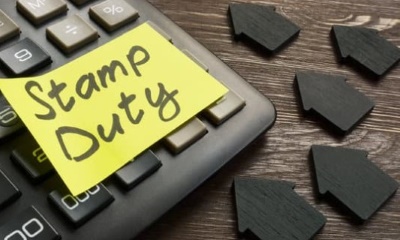
Further reading
Property guide: The issue of Japanese Knotweed
Join 'The Great Landlord's Debate' at The Property Investor Show
Check out a property's flood risk before you bid!
With the weather getting wetter and the water levels rising the flood risk areas are changing. Assessing a property for future flood risk needs to be part of your due dilligence checks as flood risk has a significant impact on insurance premiums and a property's value.
Home Insurance
Get home insurance quotes before buying to ensure suitable cover is available and doing this could flag up issues, like if the property is in a flood-risk area.
You can go to Gov.uk (England and Wales) and Environment Protection Agency (Scotland) to request reports on whether and why an area's at risk. This can reveal how vulnerable a property is, possibly saving years of stress.
Don't learn it the hard way:
"Having been flooded, I'd never buy in a risk zone again. My concerns would be getting insurance as well as the potential life-changing mess that a bad flood can cause. It seemed highly unlikely flooding would ever happen to me, so I never gave it any real thought. The day it flooded and every single item I owned got ruined was somewhat of an eye opener, I must say".
Flood risk resources:
Long term flood risk assessment for locations in England
You can use this service at Gov.uk to find out:
- how likely it is that a place could flood in the future
- what factors could cause or contribute to any potential flooding
- where to find more information about managing your flood risk
You just need to enter an English postcode to see long term flood risk information for a specific location.
Flood information for Wales, Scotland and Northern Ireland
Natural resources Wales
Scottish Environment Protection Agency SEPA
Northern Ireland nidirect
Further information guides:
Reducing the risk of flooding
Householders and landowners can take action to prevent the risk of flooding, it is important to:
- maintain all drains within your property
- clean private gullies, especially in autumn when fallen leaves can cause temporary blockages
You must not dump waste or any material in urban watercourse as this can cause blockages and flooding.
How to protect your home against flooding
You can make permanent changes to your home to reduce future flood damage. Making these alterations can reduce the time and cost of recovering from flooding.
Making changes to your home
Before undertaking any work, ask your insurer about work that can be paid for under your home insurance policy. Your insurer will usually pay for 'like-for-like' amendments - restoring your home to a similar state before the flood. You are likely to have to pay for any work beyond like-for-like amendments yourself. The cost of making your home better able to deal with flooding is likely to be a lot less than the cost of clearing up after flooding.
Alterations you may want to consider are:
- laying ceramic tiles on the ground floor
- using rugs instead of fitted carpets
- raising the height of electrical sockets to at least 1.5m above ground floor level
- using lime plaster instead of gypsum plaster on walls
- fitting stainless steel, plastic or solid wood kitchens instead of chipboard ones
- installing free-standing kitchen units that you can move
- putting main parts of a heating or ventilation system, like a boiler, upstairs or raised well above the ground floor
- fitting non-return valves to all drains and water inlet pipes, which only let water flow one way
- replacing wooden window frames and doors with man-made ones like UPVC - they are easier to clean
- installing flood resistant air bricks in place of existing vents
Reduce the impact of flooding
To reduce the impact of flooding on your home or business:
- keep a list of useful contact numbers such as your local council, emergency services and your insurance company
- agree how you and the people you live with will contact each other and where you will go if you become separated during a flood
- move your valuable belongings to safety
- know where to turn off your electricity or gas supply
- make sure your insurance provides cover against flood damage to property
- if your property is at risk of flooding, have some sandbags or floodboards or plastic covers prepared to block doorways and airbricks
- consider where to relocate your car during a flooding incident
Prepare a kit of essential items that will help you cope in a flood, including:
- copies of your home insurance documents
- a torch with spare batteries
- a battery powered or wind-up radio
- warm, waterproof clothing, rubber boots and blankets
- a first aid kit and supplies of medication needed by anyone in the house
- bottled water and tinned or dried food
- things for looking after your baby
After a flood - clearing up
You should only start the clean up when you're certain it is safe to return to your home after a flood. Get an electrician to check your electrical appliances and always wear protective clothing when cleaning surfaces, floors and walls contaminated by flood water.
Returning to a property after flooding
Before you start to clear up, you should:
- find out if it’s safe to return to your property
- ask your insurance company if they will organise professional cleaners to clean your home
If you were evacuated because of flooding, you’ll be told it’s safe to return home by:
- the emergency services
- your insurance company
- your council
- Department for Infrastructure
- Water Authority
Check your electricity supply and electrical appliances
Before you start clearing up:
- check that the electricity supply is switched off at the mains
- if you aren’t sure the electricity is turned off, get a qualified person to do this
- don’t touch sources of electricity while standing in floodwater
- get any electrical appliances that have come into contact with floodwater checked by a qualified electrician before using them again
Protecting yourself while cleaning up
Make sure you wear protective clothing when you clean up following a flood. Floodwater can be contaminated with sewage, chemicals and animal waste. You’ll need to disinfect anything that comes into contact with it.
You should always:
- wear protective clothing, like a waterproof jacket and trousers and rubber gloves
- use a face mask
- wash your hands with disinfectant if you have been in contact with floodwater, mud or handled items that have been in contact with floodwater
- make sure any open cuts or wounds on exposed skin are covered by a waterproof plaster
Looking after your health while cleaning up
Clearing up after a flood can be stressful and you can get ill from pollution or sewage in flood water. If you start to feel unwell contact your GP.
Getting rid of floodwater
Once the water levels are lower outside than inside your property, you can begin to get rid of the water by using a pump or bucket. You can hire or buy a pump and generator from a DIY shop.
Make sure you put the generator outside to avoid carbon monoxide poisoning from the exhaust.
Cleaning surfaces in your home
You will need to do an initial clean and follow this by disinfecting all surfaces that were contaminated by floodwater.
You can clean contaminated surfaces with a brush, hot water and household cleaning fluid.
Don't forget to clean enclosed spaces under kitchen units or floorboards. If floodwater was contaminated with oil or diesel, you’ll need to use a detergent like washing up liquid.
Once you have finished cleaning, use household disinfectant on everything that has come into contact with floodwater.
You will need to wash contaminated clothing and bedding at a high temperature.
Drying the building
Drying out can take weeks or months, depending on how serious the flooding has been and the type and thickness of the building materials.
You can use your central heating to help dry out the house once the heating system has been checked by a qualified engineer.
For best results the temperature should be set at 20 to 22 degrees centigrade.
You can speed up the drying process by keeping the building well ventilated by opening as many windows and doors as possible and using a fan.
If you use a dehumidifier to remove water from the air in your home, you need to keep external doors and windows shut.
Major redecoration or repair work
Get professional advice from a builder if you need to do any major redecoration or repair work on your home following a flood. Make sure you choose a builder recommended by your local council or insurance company.
New legislation applies to areas under development
Read more about the legislation and exemptions in this article: What is a flood risk activity permit & why do I need one?
Want to see what is coming up for sale in your area or what price properties have sold for?
You need access to www.eigpropertyauctions.co.uk, the only site with information on virtually every lot coming to auction.
Get access to industry knowledge with full visibility of what is coming up for sale and what similar properties have sold for.
Try it for free, call us now to experience your no obligation trial: 01737 226150
Essential Information Group - News and Information
Keep up to date with our latest news, case studies and what's going on in the property auction industry on our blog.

Buying at auction
20/03/2025
Why the Property Auction Market is Booming Due to Stamp Duty Changes
The UK property auction market is experiencing a surge in activity in March 2025, driven primarily by impending changes to stamp duty regulations

Buying at auction
27/02/2025
Who Can Benefit from Buying a Property at a UK Property Auction?
Buying a property at a UK property auction can be advantageous for various buyers depending on their financial situation and goals. Auctions often offer unique opportunities, discounted properties, and a fast purchase process. Here’s who can benefit the most.

Buying at auction
24/02/2025
Bridging Loans Explained: A Guide for Property Auction Buyers
A bridging loan is a short-term financing solution, typically lasting up to 12 months. It provides immediate funds to bridge the gap between purchasing a property and securing long-term financing.